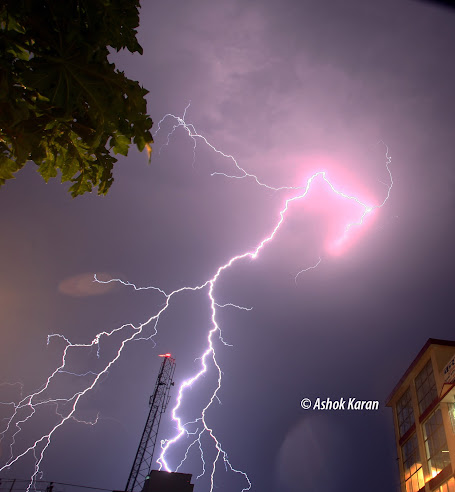Lightning
– How I Shot It
With the monsoon sweeping across
large parts of the state and spreading into Northern India, it has brought
much-needed relief from the intense summer heat. The pleasant weather lifts
people’s spirits and fills the air with joy, while hearts yearn for delicious
treats. Yet, this season hasn’t been without its hardships. Widespread
destruction has been reported in states like Himachal Pradesh, Uttarakhand,
Punjab, New Delhi, Gujarat, and others, claiming over 350 lives and damaging
lakhs of acres of farmland and livestock.
Despite the destruction, many still
wish the rains would never stop. For farmers, this season is a blessing, vital
for their crops. Scientists even point out that rainfall improves mental
well-being and brings happiness. Walking through the rain with an umbrella or
raincoat is a simple pleasure that many enjoy. However, monsoon rains also
bring floods, cloudbursts, and diseases like influenza, cholera, chikungunya,
malaria, and other viral fevers—particularly in July and August. In North Bihar’s
rural regions, floods remain an endless, perennial challenge. Disasters like
the cloudburst at Kedarnath in 2013, which killed thousands of pilgrims, are
tragic reminders of the monsoon’s fury.
The monsoon brings both joy and
grief. It begins with dark clouds gathering, followed by flashes of lightning
that mesmerize the young and old alike. The romance of rain is deeply rooted in
culture—just look at how Hindi films celebrate the rainy season with memorable
songs and visuals.
While capturing the beauty of rain
and clouds, I decided to photograph lightning—the spectacular natural
thunderbolt. Knowing its characteristics made me more determined: lightning
travels 30,000 times faster than a bullet, can reach temperatures of 54,000°F,
which is about five times hotter than the sun’s surface, and strikes 20
million times a year in the U.S. alone! Lightning is the result of
electrostatic discharges between charged areas in the atmosphere, creating a
sudden imbalance that flashes across the sky. I still remember learning in
school that light travels faster than sound—lightning being the perfect
example.
For
Beginners – How to Capture Lightning
Many young photographers dream of
capturing thunder and lightning but struggle due to its ultrafast nature.
Photographing lightning requires patience, precision, and alertness—there’s a
lot of trial and error involved. Here’s how I approached it:
Camera Setup:
I used the Canon EOS 1D Mark III paired with a 16-35mm short zoom
lens, perfect for wide-angle shots that capture both sky and landscape.
Exposure Tips:
- Use a tripod
to stabilize the camera—essential for long exposures. - Set a long shutter speed, around 15 or 30 seconds in the evening.
Anything beyond 1/60th of a second is considered a long exposure. - Focus at infinity
to ensure sharpness throughout the frame. - A long exposure also helps capture the ambient mood of
the environment. - Set ISO between 100 and 400, depending on available light.
- Use an aperture of f/16 or higher to prevent the lightning from being overexposed.
- Longer exposure simply means the aperture stays open
longer, letting more light in. - A common myth is that you need a high shutter speed to
capture lightning—but it’s actually the opposite! With lightning traveling
at around 186,000 miles per hour, high-speed settings won’t catch
it effectively. Long exposures are the key.
A
Note on Lightning Safety
Lightning strikes are frequent in
plateau regions like Jharkhand, and cases are on the rise. Authorities
regularly issue warnings during heavy storms. Recently, Times of India
reported four deaths due to lightning strikes in Jharkhand—a stark reminder
to stay cautious during the stormy season.
Photography is about patience and
persistence, especially when chasing nature’s
fleeting moments. With practice, you’ll learn to anticipate, prepare, and
capture stunning shots that few others can.
Picture of a Thundering.
📸 Text & Photography
by – Ashok Karan
🌐 ashokkaran.blogspot.com
If you enjoyed this guide, please like
and share!
#LightningPhotography
#MonsoonMagic #CanonPhotography #NatureLovers #StormChasers #PhotographyTips
#RainySeason #Electrostatics #TravelPhotography #AshokKaran



Leave a Reply